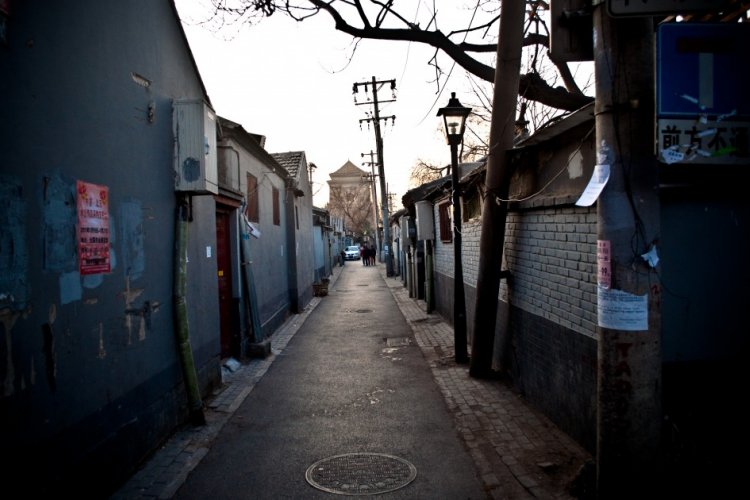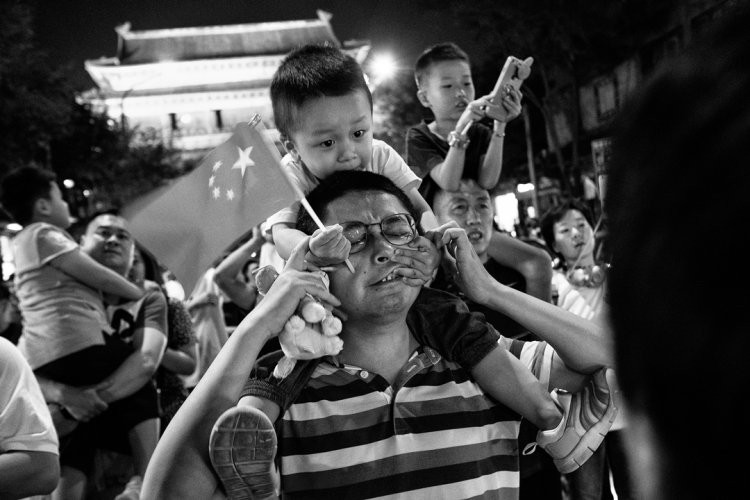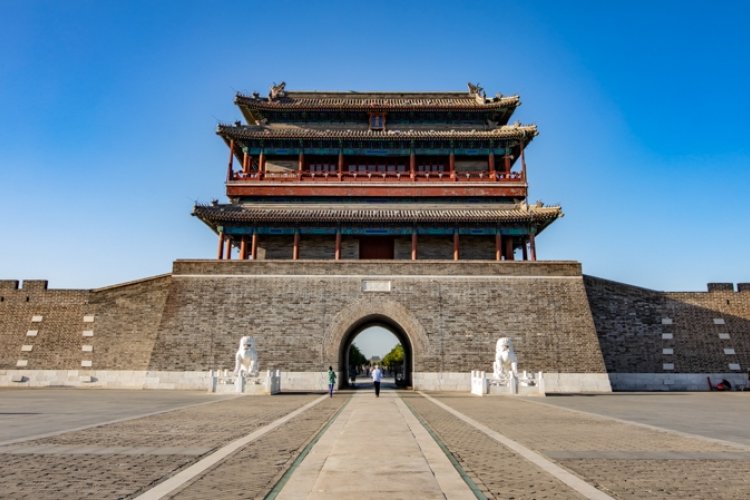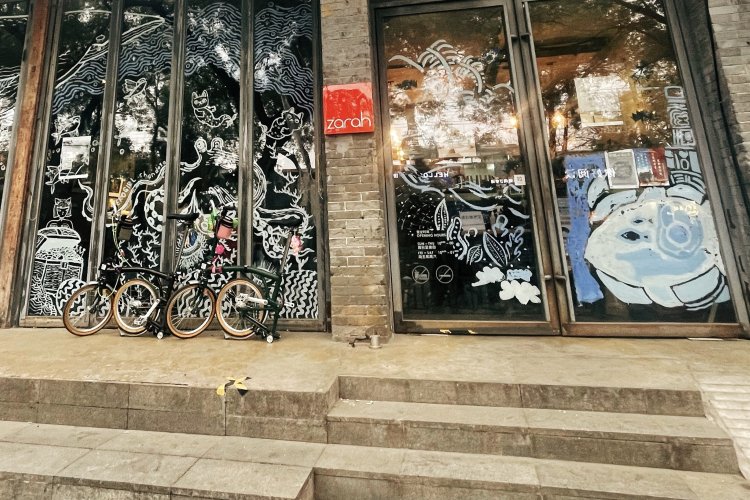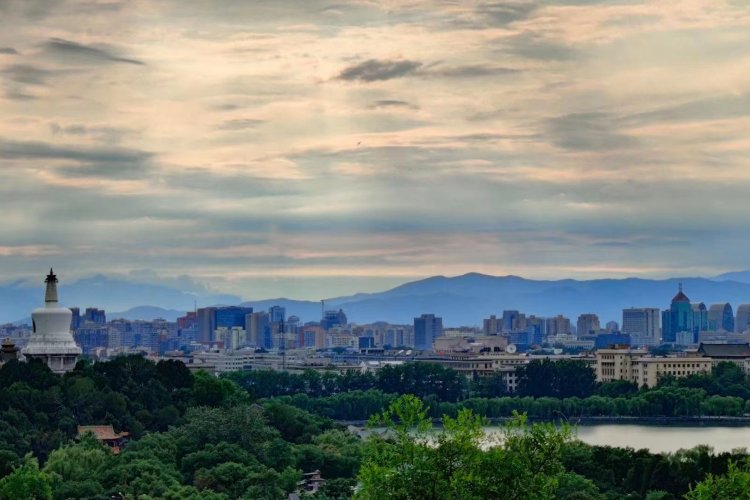Quiet Glimpses, Distant Places: A Journalist Casts Her Gaze Over Beijing
Whew, dear reader! How's the new year treating you? Are those resolutions already on their way? No biggie if you haven't got any. I for one would be pleased as punch with a quiet, calm year that goes gentle on us all.
Because, you see, here's the deal – I function best when I am able to focus on my immediate surroundings and the small pleasures they grant me. What a luxury it is to go about life leisurely, truly soaking in the moment. When we're keen to take a good look around us, we step out of our main character syndrome and notice that there's so much more. People going about their lives, corners of wonder, angles unexpected... Boy, do I love me an eyeful of the city!
Well, patrons of beloved hutong spot Zarah have been enjoying a treat of this sort recently. In late November, photographer and journalist Lidia Stanchenko held a private showing for her solo exhibition “Quiet Glimpses, Distant Places.” And look, if you haven't checked it out yet, I get you. Winter is cold and unpleasant, we're barely emerging from the Christmas haze, and is that Chinese New Year lurking around?
Lucky you, then, that Lida's photography will grace the walls of Zarah until Feb 12. Lucky me, too, because I've been meaning to sit down with her for a little interview, and I'd hate to miss out on the chance to learn more about her work and the gaze that she casts on our shared stomping grounds. I started off this blog post bringing up New Year resolutions, didn't I? Here's one of mine: In 2025, I want to keep myself finely tuned in to all things culture. So, here we go – up close and personal with Lidia Stanchenko.

Hello, Lidia! So happy that my first blog post of the year is going to be our conversation. “Quiet Glimpses, Distant Places” is a showcase of urban photography snapped across China. Beijing is featured most prominently, but you've also brought your camera to cities such as Hangzhou and Fuzhou. There's so much I want to ask you, but I suppose we can start with the exhibition's title. The idea of “distance” is intriguing to me here because even as a foreigner in this land, you've called China home for the last four years. I would like you to expand on the meaning of this title, and the ways in which what's quiet and what's distant interact.
Why, thank you. I'm thrilled! The title “Quiet Glimpses, Distant Places” holds a lot of personal meaning for me, especially in the context of my time in China. Those “quiet glimpses” speak to the subtle, often unnoticed moments I've captured through my lens. It's about finding beauty and significance in the every day – in moments that carry profound resonance, even if they might seem insignificant to a passerby.
There are probably several layers of meaning to “distant places.” This part of the title reflects firstly on the physical act of traveling to cities like Fuzhou, Hangzhou, or even the hidden corners of Beijing. Simultaneously, it also alludes to a sort of emotional and cultural distance. Even after four years, there's always a sense of discovering something new or seeing the familiar through a different lens. But perhaps, more than anything, with the word “distant” I wanted to convey the idea that almost all of my photos are observations made from a distance. It's this feeling of observing a place or people intimately while giving them the space to be themselves, unaware of how much inspiration they are offering.

Fascinating. My second question is also related to interaction, in a way. Being a full-time journalist, I imagine your camera stands as a work tool on an everyday basis. However, “Quiet Glimpses” is a collection of personal work – a more private gaze cast upon spaces that you would otherwise photograph for professional purposes. I am curious whether you approach both – the personal and the professional – in different ways. Does the line ever bleed into both sides of your photography practice, or do you manage to keep neat spaces for each?
Indeed, I often use my camera for work, though I am primarily a writing journalist – most of my work revolves around words. You're absolutely right that the works featured in the exhibition represent a more private gaze. For me, photography outside of work is a kind of diary – my medium of choice to illustrate my vision of the world around me and my place in it. At one point – especially when I first moved to China – photography even became a form of therapy for me.
Although I did study in Nanjing before (2011-2012), moving to China in 2018 was still mentally challenging. Work and study require very different levels of responsibility. It was in this new chapter of my life that my camera allowed me to see beauty in places where I otherwise wouldn't have noticed it.
Returning to your question about the difference between personal and professional photography, my personal photos are documentary in nature – spontaneous moments captured “out in the open air,” you might say. They happen outside the context of any given event. In contrast, journalistic photography does always require context. Photos must be clearer, and more “polished,” so to speak. The element of drama doesn't happen within the image itself but rather unfolds in the event or story behind it.
For this reason, it's relatively easy for me to separate these two approaches. That said, journalistic and documentary photography do often overlap.

Awesome. I think this is a recurring reflection of any professional creative. Now, on to the photographs themselves. I think a common deterrent for prospective urban photographers is overcoming the sheer awkwardness of having your subjects' consent, whether active or passive, to take their picture. One could certainly just steal whatever angle they can from a distance, but the result will fall short of technical standards, and it will probably also lack closeness. Urban landscapes don't require consent, but eventually, you're going to want to interact with the people that inhabit them. So, how do you go about it? Could it be that newbies overthink it?
Indeed, overcoming shyness or even fear of invading someone's space with your camera can be challenging. Even now, when I photograph people, I still find myself pushing through something internally. Ultimately, it all depends on the situation – you just have to sense what feels more appropriate. Personally, I never follow a strict approach.
Sometimes I ask for permission to take a photo, except often they'll start posing, which is a problem. I then ask them to just continue doing whatever they were doing – don't pay attention to me! Surprisingly, they usually comply. Generally, though, people in China are not particularly averse to being photographed, and if you're willing to speak a little Chinese with them, it should be easy to win them over.

There are also times when I want to take a picture after striking up a conversation with my subject. Alternatively, investing in a good zoom lens will make it so that people won't even notice that they're being photographed. That being said, it's always a good idea to read up on local laws. In some countries, for example, photographing children or military personnel is prohibited. In others, street photography might be banned altogether.
Whenever I want to photograph someone, I raise a question to myself – how well will the scene translate into a photograph? The scene that looks so great in reality might not work for your photo – the angle could be wrong, or the lighting less than ideal. In such cases, it's better to just walk away and not disrupt the natural flow of life with a camera.
But then, there are moments when the light is just perfect, and the subject or the mise-en-scène is so captivating, that you realize you'll be consumed by regret if you don't freeze that moment in a photograph. So you go for it, following your gut, even though there's always a probability that the result will not quite match your expectations.

I see, taking notes over here. And speaking of people, my two favorite pictures in “Quiet Glimpses” have to be “Cellist” and “Evening Accordionist” – taken in Beijing in 2023 and 2024, respectively. Both share the same subject: a certain neighbor close to 64 Dongsishiyitiao who takes pleasure in his daily musical practice and who former patrons of Camera Stylo (sob) will probably remember. Here I am, begging you to share the story behind these two pictures.
I'm so glad to hear that because these two photographs are also among my favorites in this collection. This lovely old man lives just a short distance from my home; we're both in the hutongs, and the windows of his house face the street. He owns a variety of musical instruments, some of which he plays professionally, while others he's still learning. I often pass by his house when I walk my dog, and he doesn't draw the curtains, so it's easy to catch glimpses of him practicing different instruments in the evening. The photograph “Evening Accordionist” was taken during one of those walks. I walked by and couldn't help but smile when I saw the scene. One of those moments where I truly must take a picture.

As for “Cellist,” that photograph came after a short conversation with him. He was practicing right outside his house, on the street. I stopped and smiled at him, and he smiled back, asking where I was from. He shared that he had only recently started learning the cello after doctors told him that due to a certain illness he might lose the use of his hands. Playing the cello became his choice of exercise to try and keep his hand dexterous.
When he learned I was from Russia, he tried to play “Katyusha.” That's the moment I captured him in the photograph. Since then, we always greet each other when we pass by. Our dogs are on rather friendly terms by now.

The technical merits of the pieces making up “Quiet Glimpses” are there for sure; I am thinking of the brilliant composition in “More than Just a Dancer” where the main subject carries the weight of the photograph not just through his pose, but also in the bright red scarf that breaks up an otherwise gloomy, wintery palette. Meanwhile, there's a glimpse into the festive and the extraordinary in “Coquettes in Chignons.” There's even an outlier – “Catwalks in the Rain” – the one photograph that seems to elude the general theme of the exhibition. But “Quiet Glimpses” speaks on a most immediate level to me through the powerful quotidian nature of the scenes featured in the exhibition. Sunlight dapples over a scene of unmentionables drying from a hutong window; a man carries maintenance tools in the desolate winter landscape of the Summer Palace; retirees are engrossed by a game of mahjong; a hawker sprays some water on his cargo of lotus seed pods. We've been there; we've witnessed scenes like these. And so have you, with your camera in tow. What's the purpose of capturing everyday life to you? How do you frame this observation of your surroundings?
For me, capturing everyday life is about finding significance in the seemingly insignificant. When I frame these observations, I try to approach them with curiosity and humility. I don't set out to make grand statements with my photos; instead, I aim to let the subjects and their surroundings speak for themselves. Additionally, as I've mentioned before, photography for me is like keeping a diary. When you write your thoughts down on paper, it often helps you notice things in your surroundings that you hadn't seen or paid attention to before. Photography works in much the same way – the ordinary starts to transform when you take an unusual angle or notice the uniqueness of a shadow.
I often find, when going back to photos I initially deemed unsuccessful, that they eventually become incredibly meaningful, sometimes years down the road. That's how time works; that's how everything changes. Even if this thought isn't always in my mind, it's certainly true, in this sense, that any photograph of everyday life has the potential to eventually become a small piece of history.
However, when I was choosing from my photo archive for this exhibition, I found myself completely immersed in the emotions I felt when I first arrived. My experiences, the things that brought me joy or else sparked my curiosity or wonder – it all came flooding back. I hadn't realized how clearly I'd be able to see how much I've changed over these years. It was a fascinating reflection that reminded me, once again, of my purpose in doing this all.

Truly fascinating. It could be argued that as foreign guests in this land we have a certain responsibility in the gaze that we cast around. If we are to add to a discourse, we shouldn't take it mindlessly, so to speak. How do you approach the stories you tell through your photographs, and how do you navigate cultural differences and potential imbalances and challenges?
That's a very interesting question. Cultural differences and potential imbalances are always there, but I think navigating them starts with listening and learning, rather than assuming. Photography, for me, is a dialogue – one where I aim to honor the story of the people and places I photograph, rather than just capturing an image for its own sake.
I'm not interested in capturing stereotypes or highlighting the less flattering aspects of a country just to prove a point or confirm a theory. What interests me is the dialogue – a dialogue between my camera and the world around me and the people who inhabit it.
My camera is a tool through which I satisfy my genuine curiosity, to a certain extent at least. Genuine curiosity, a desire to understand, and respect – I believe these are the main pillars for overcoming imbalances and prejudices.

Certainly insightful, thank you. I am not sure whether this is your first exhibition. Are there any others planned for 2025? Otherwise, what are your creative resolutions for the year, if any?
Yes, this exhibition was my debut, and I'm incredibly grateful to Zarah for their recognition and support. In 2025, I want to focus a bit more on portrait photography – it's another passion of mine. As for my creative resolutions for the year, I'd say, “Don't fear unsuccessful shots and keep searching.”

Lidia Stanchenko's exhibition “Quiet Glimpses, Distant Places.” is currently on show at Zarah until Feb 12. Entry to the exhibition is free.
Zarah
46 Gulou Dongdajie, Dongcheng District
东城区鼓楼东大街42号
Hours: Sun-Thu, 10am-midnight; Fri-Sat, 10am-1am
Phone: 010 8403 9807
READ: Get Boozy Over Spring Festival With These CNY Beer Packages
Pictures courtesy of Lidia Stanchenko


